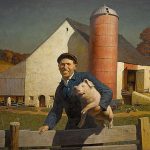Harvey Thomas Dunn, a renowned American painter and illustrator, emerged from the vast prairies of South Dakota to become a prominent figure in the art world of the early 20th century. Born on March 8, 1884, in Manchester, South Dakota, Dunn’s formative years were deeply intertwined with the rugged landscapes and pioneer spirit of the American Midwest. Raised on a homestead, Dunn’s childhood experiences would later fuel his artistic passion and shape the narrative of his prolific career.
Growing up in an environment where self-sufficiency and resilience were paramount, Dunn displayed an early aptitude for drawing. His artistic inclinations were encouraged by his mother, and his sketches often depicted scenes of daily life on the prairie. Recognizing her son’s potential, Dunn’s mother arranged for him to study art under Ada Caldwell, a local artist who played a pivotal role in nurturing Dunn’s burgeoning talent.
In 1901, Harvey Dunn left the prairies for Chicago to enroll at the Art Institute of Chicago, where he studied under renowned artists such as Frank DuMond and John H. Vanderpoel. The bustling city provided a stark contrast to the quiet landscapes of his youth, and Dunn’s exposure to the academic traditions of the time laid the groundwork for his future artistic endeavors.
The Mentorship of Howard Pyle
One of the defining chapters in Harvey Dunn’s artistic journey unfolded when he became a student of the legendary Howard Pyle at the Howard Pyle School of Art in Wilmington, Delaware. Pyle, a pioneering figure in American illustration, recognized Dunn’s potential and became a mentor who profoundly influenced the trajectory of Dunn’s career.
Under Pyle’s tutelage, Dunn honed his skills in narrative illustration, a genre that would become synonymous with his name. Pyle’s emphasis on storytelling and the power of visual narrative resonated deeply with Dunn, and he quickly became one of Pyle’s most promising students. The school’s focus on historical accuracy and a meticulous approach to depicting scenes with emotional resonance left an indelible mark on Dunn’s artistic philosophy.
Dunn’s illustrations began to grace the pages of prominent magazines, including The Saturday Evening Post and Harper’s Weekly. His ability to convey emotion and capture the essence of a story through his illustrations garnered widespread acclaim. Dunn’s work became a staple in American households, with his images often providing a visual narrative for the stories and events of the time.
From War to the Prairie
The outbreak of World War I marked a significant turning point in Harvey Dunn’s career. Commissioned as an official artist by the U.S. Army, Dunn documented the experiences of American soldiers on the Western Front. His powerful and emotive war paintings, depicting the harsh realities of trench warfare, earned him accolades and contributed to the visual record of the Great War.
Dunn’s war paintings, including “The Return of the Colors” and “The Tin Hat,” reflected his commitment to capturing the human side of conflict. These works transcended traditional war art by delving into the emotional toll and camaraderie among soldiers. Dunn’s experiences during the war profoundly influenced his later works, and themes of sacrifice, resilience, and the human spirit remained central to his art.
After the war, Dunn continued his career as a painter and illustrator, but he also returned to the prairies of South Dakota, where he found inspiration in the enduring spirit of the American heartland. His post-war paintings, such as “Wounded” and “The Prairie is My Garden,” showcased his ability to evoke deep emotion and celebrate the resilience of the human spirit.
Dunn’s Enduring Influence
Harvey Dunn’s legacy is woven into the fabric of American art history. His contributions to narrative illustration, war art, and the celebration of prairie life have left an indelible mark on the artistic landscape. Dunn’s work is held in esteemed collections, including the National Museum of American Illustration and the South Dakota Art Museum.
As an educator, Dunn continued to inspire future generations of artists. He became a teacher at the Grand Central School of Art in New York, passing on the lessons and principles he had learned from Howard Pyle. Dunn’s dedication to storytelling, emotional depth, and technical excellence resonated with his students, shaping the next wave of American illustrators and painters.
Harvey Dunn’s journey from the prairies of South Dakota to the forefront of American art reflects a profound connection to the human experience. His ability to capture the essence of everyday life, the sacrifice of war, and the enduring spirit of the American heartland cements his place as a master storyteller and visual poet. Dunn’s legacy endures not only in his paintings but in the narrative threads he wove through the canvas of American art, immortalizing the stories of a nation and the resilient spirit of its people.






